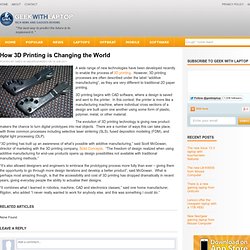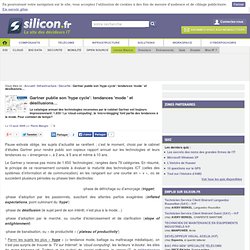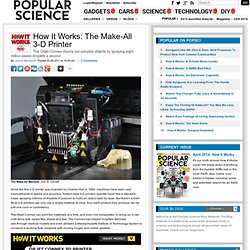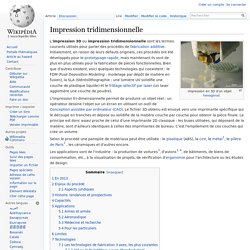

Lithographie. Un article de Wikipédia, l'encyclopédie libre.

Inventée par Aloys Senefelder à partir de 1796 en Allemagne, la lithographie (du grec lithos, « pierre » et graphein, « écrire ») est une technique d’impression qui permet la création et la reproduction à de multiples exemplaires d’un tracé exécuté à l’encre ou au crayon sur une pierre calcaire. Lithogravure et microlithographie[modifier | modifier le code] La lithographie ne doit pas être confondue avec la lithogravure, car celle-ci consiste à graver en creux (ou en relief) des plaques de pierre et est relativement peu utilisée pour produire des estampes. C'est aussi un procédé photomécanique et chimique qui permet de réaliser des composants de micro-électronique : voir microlithographie. Sous l’influence de l’anglais lithography le mot lithographie est utilisé dans divers composés en rapport avec les micro-technologies, sans rapport avec le procédé d’estampe décrit ici. Singularité technologique.
Www3D.free.fr - Les sites du monde IMPRIMANTE 3D. Comment imprimer des objets chez soi ! Is 3D printing the next great technological disruption? How 3D Printing is Changing the World. A wide range of new technologies have been developed recently to enable the process of 3D printing.

However, 3D printing processes are often described under the label “additive manufacturing”, as they are very different to traditional 2D paper printing. 3D printing begins with CAD software, where a design is saved and sent to the printer. In this context, the printer is more like a manufacturing machine, where individual cross sections of a design are built upon one another using some form of plastic, polymer, metal, or other material. The evolution of 3D printing technology is giving new product makers the chance to turn digital prototypes into real objects. There are a number of ways this can take place, with three common processes including selective laser sintering (SLS), fused deposition modeling (FDM), and digital light processing (DLP). Gartner publie son 'hype cycle': tendances 'mode ' et désillusions… Pause estivale oblige, les sujets d’actualité se raréfient ; c’est le moment, choisi par le cabinet d’études Gartner pour rendre public son copieux rapport annuel sur les technologies et leurs tendances ou « émergence », à 2 ans, à 5 ans et même à 10 ans.

Le Gartner y recense pas moins de 1.650 ‘technologies’, rangées dans 79 catégories. En résumé, le principe de ce recensement consiste à évaluer la maturité des technologies ICT (celles des systèmes d’information et de communication) en les rangeant sur une courbe en « v », où se succèdent plusieurs périodes ou phases bien disctinctes: -phase de défrichage ou d’amorçage (trigger) -phase d’adoption par les passionnés, suscitant des attentes parfois exagérées (inflated expectations, point culminant du ‘hype‘) S Hype Cycle Special Report for 2011. Already a Gartner client?

Sign in to view this research document. Forgot username or password? How It Works: The Make-All 3-D Printer. Since the first 3-D printer was invented by Charles Hull in 1984, machines have seen vast improvements in speed and accuracy.

Today's best 3-D printers operate much like a standard inkjet, spraying millions of droplets of polymer to build an object layer by layer. But there's a hitch: Most 3-D printers use only use a single material at once, thus each product they produce can be just one color or consistency. The Objet Connex can print two materials at a time, and even mix composites. In doing so, it can craft items with varied flex, shade and feel. The Connex has helped hospitals fabricate see-through medical models and even allowed a Massachusetts Institute of Technology student to construct a working flute complete with moving hinges and rubber gaskets. Click the image above to see an animation showing how the Objet Connex can print complex objects one microscopic layer at a time.
More How It Works: This month's How It Works section is brought to you by Digi-Key. 3D Printing. You are in: Future Technologies : 3D Printing 3D Printing Imagine a future in which a device connected to a computer can print a solid object.

A future in which we can have tangible goods as well as intangible services delivered to our desktops or highstreet shops over the Internet. And a future in which the everyday "atomization" of virtual objects into hard reality has turned the mass pre-production and stock-holding of a wide range of goods and spare parts into no more than an historical legacy. Such a future may sound like it is being plucked from the worlds of Star Trek. The following provides an overview of 3D printing technologies and their present and likely future application. Machines d'impression 3D - machines d'impression 3D Fabricants, Fournisseurs et Exportateurs sur french.alibaba.com. 3D printing provides a vision of manufacturing's future (w/ video) Dan Mishek, co-owner and head of VistaTek, with a prototype bust of Walt Disney.

It was made using 3D printing technology at Mishek's company in Vadnais Heights. (Pioneer Press: Richard Marshall) Dan Mishek and his siblings operate VistaTek, a small manufacturing concern in Vadnais Heights started by his parents 15 years ago. To hear him tell it, they're running Santa's workshop.
Or a small arms factory. "My favorite story is that at one point, we were making children's toys, an assault rifle, a hearing aid and a horse manure pitchfork, all at the same time," Mishek said. VistaTek doesn't suffer from mission confusion. Something that might take weeks with traditional molds and methods can be done overnight by pushing a button. In the world of manufacturing, it's called rapid prototyping. Impression 3D.
Un article de Wikipédia, l'encyclopédie libre.

L'impression 3D ou impression tridimensionnelle sont les termes courants utilisés pour parler des procédés de fabrication additive. Initialement, en raison de leurs défauts originels, ces procédés ont été développés pour le prototypage rapide, mais maintenant ils sont de plus en plus utilisés pour la fabrication de pièces fonctionnelles.